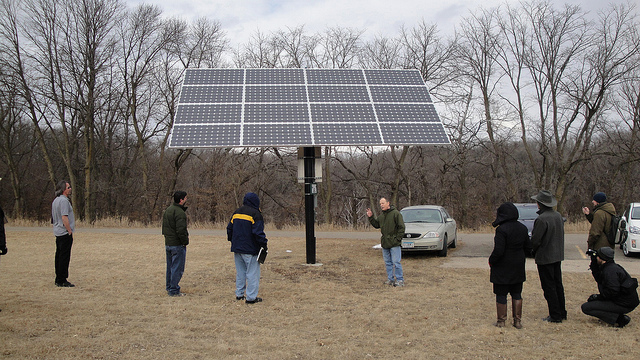May 23, 2012


SB 843, a bill currently moving through California State Legislature, would allow utility customers to receive their energy from a community solar facility. Rather than installing panels on individual homes, a solar company would install concentrated amounts of solar panels in public area. Residents would then be able to buy into the energy generated by the solar array. Suddenly, living in an apartment building or having a shadowed roof would no longer limit solar participation! (Photo by CERTs, Flickr)
[nggallery id=209 template=carousel images=8][imagebrowser id=209]
By Courtney Hayden May 22, 2012
Let’s say you live in a beautiful apartment building in San Francisco or Los Angeles. You love finding alternatives to driving, yet you still receive a monthly reminder of your fossil fuel dependence: a hefty electricity bill. You support renewable energy, but how could you possibly install solar panels? Even if you did become a homeowner, how would you finance a solar array? Or what if your roof is shaded?
Across California, many people grapple with the urge to support a renewable energy, and the inability to do so at home. In fact, 75% of Californian households are unable to participate in rooftop solar. Renewable energy should be easy. Californians, who are famous for the time and energy they dedicate to living an environmentally friendly lifestyle, should all have the option to purchase renewable energy.
SB 843, a bill currently moving through California State Legislature, would allow utility customers to receive their energy from a community solar facility. Rather than installing panels on individual homes, a solar company would install concentrated amounts of solar panels in public area. Residents would then be able to buy into the energy generated by the solar array. Suddenly, living in an apartment building or having a shadowed roof would no longer limit solar participation!
How exactly would it work? “A community renewable energy facility would sign an agreement with utility customers to sell them renewable energy. Customers (would then) receive credit on their utility bill for their share of renewable electricity delivered to the grid,” explains E2, an independent coalition of business leaders for sound environmental policy.
It is no secret that Sierra Club Green Home advocates for renewable energy, and we look forward to it becoming more accessible! The California State Government is still considering SB 843, and The California Assembly Utility and Commerce Committee is scheduled to hear it soon. Stay tuned for updates on the bill.
For related articles, see: Community Solar: Bringing People Together for Clean Energy Solar Incentives for Los Angeles and San Diego Homeowners
© 2012 SCGH, LLC.
]]>